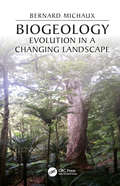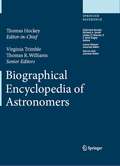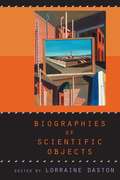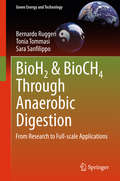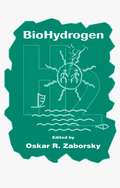- Table View
- List View
Biogeology: Evolution in a Changing Landscape (CRC Biogeography Series)
by Bernard MichauxThis detailed exposition gives background and context to how modern biogeography has got to where it is now. For biogeographers and other researchers interested in biodiversity and the evolution of life on islands, Biogeology: Evolution in a Changing Landscape provides an overview of a large swathe of the globe encompassing Wallacea and the western Pacific. The book contains the full text of the original article explored in each chapter, presented as it appeared on publication. Key features: Holistic treatment, collecting together a series of important biogeographical papers into a single volume Authored by an expert who has spent nearly three decades actively involved in biogeography Describes and interprets a region of exceptional biodiversity and extreme endemism The only book to provide an integrated treatment of Wallacea, Melanesia, New Zealand, the New Zealand Subantarctic Islands and Antarctica Offers a critique of fashionable neo-dispersalist arguments, showing how these still suffer from the same weaknesses of the original Darwinian formulation. The chapters also include analysis of many major theoretical and philosophical issues of modern biogeographic theory, so that those interested in a more philosophical approach will find the book stimulating and thought-provoking.
Biographical Dictionary of American and Canadian Naturalists and Environmentalists
by George A. Cevasco Lorne Hammond Richard Harmond Keir B. SterlingCasting a wide net, this volume provides personal and professional information on some 445 American and Canadian naturalists and environmentalists, who lived from the late 15th century to the late 20th century. It includes explorers who published works on the natural history of North America, conservationists, ecologists, environmentalists, wildlife management specialists, park planners, national park administrators, zoologists, botanists, natural historians, geographers, geologists, academics, museum scientists and administrators, military personnel, travellers, government officials, political figures and writers and artists concerned with the environment. Some of the subjects are well known. The accomplishments of others are little known.Each entry contains a succinct but careful evaluation of the subject's career and contributions. Entries also include up-to-date bibliographies and information concerning manuscript sources.
Biographical Encyclopedia Of Astronomers: (pdf) (Springer Reference Ser.)
by Thomas Hockey Thomas Williams Jordan D. Marché Katherine Bracher Marvin Bolt Richard Jarrell JoAnn Palmeri F. Jamil Ragep Virginia TrimbleBiographical Encyclopedia of Astronomers
by Thomas Hockey, Virginia Trimble, Thomas R. Williams, Katherine Bracher, Richard A. Jarrell, Jordan D. Marché, JoAnn Palmeri and Daniel W. E. GreenBiographical History of Behavioral Neuroendocrinology
by Randy J. Nelson Zachary M. WeilBehavioral neuroendocrinologists are interested in the interactions between hormones and behaviors. This unique book tracks the development of behavioral neuroendocrinology from the first recognized paper in the field by Arnold Berthold in 1849 to the major contributors of the past century. It traces the history and development of the field by exploring the women and men who conducted the studies that revealed these hormone-behavioral relationships. Most chapters are written by the individuals who knew these pioneers best, and describe their stories and discuss the ways in which their work has shaped the field. Now is the perfect time for this book. The field is burgeoning and interest in the development of theoretical perspectives is thriving. Moreover, although this field was dominated by men early on, it has become a field with near sexual parity among its faculty, society membership, and leadership, and thus serves as an example of equitable science, training, and advocacy.
Biographien von Pflanzensippen
by Rudolf ScharfetterDie Geschichte der Pflanzenwelt ist das großartigste, das höchste und letzte Ziel, das wir mit allen unseren botanischen Forsch- gen erstreben. · A. V. KERNER, Pflanzenleheu, 2. !3d. , S. 4. Der etwas sonderbar anmutende Titel dieses Buches wird sofort verständlich, wenn ich an die Biographien bedeutender Menschen erinnere. In der Regel wird zunächst unter Angabe ihrer Geburtsdaten von ihren Eltern und Vorfahren und dem Erbgut berichtet, das sie von diesen als körperliche und geistige Anlagen mitbekommen haben. Jeder Mensch wird nun in eine bestimmte, zeitbedingte Um welt hineingeboren; je nach seinen Anlagen setzt er sich mit dieser Umwelt auseinander; es ist sein Schicks a I, ob er in Friedens- oder in Kriegszeiten geboren wurde, ob er Gele genheit hat, seine Anlagen zu entfalten oder ob er sich gegen ein widriges Geschick durchsetzen muß. Mit der Umwelt, die sich im Laufe der Zeit ändert, wechseln die Geschicke des Einzelnen, die Ausbildung einzelner Anlagen wird durch die Gunst der Zeit gefördert, die Ausbildung anderer gehemmt: der Mensch bewährt sich oder er versagt in den verschiedenen Lebenslagen, in die ihn im Laufe der Zeit sein Schicksal ver setzt.
Biographies in the History of Physics: Actors, Objects, Institutions
by Christian Forstner Mark WalkerThis book sheds new light on the biographical approach in the history of physics by including the biographies of scientific objects, institutions, and concepts. What is a biography? Can biographies also be written for non-human subjects like scientific instruments, institutions or concepts? The respective chapters of this book discuss these controversial questions using examples from the history of physics. By approaching biography as metaphor, it transcends the boundaries between various perspectives on the history of physics, and enriches our grasp of the past.
Biographies of Scientific Objects
by Lorraine DastonWhy does an object or phenomenon become the subject of scientific inquiry? Why do some of these objects remain provocative, while others fade from center stage? And why do objects sometimes return as the focus of research long after they were once abandoned? Addressing such questions, Biographies of Scientific Objects is about how whole domains of phenomena—dreams, atoms, monsters, culture, society, mortality, centers of gravity, value, cytoplasmic particles, the self, tuberculosis—come into being and sometimes pass away as objects of scientific study. With examples drawn from both the natural and social sciences, and ranging from the sixteenth to the twentieth centuries, this book explores the ways in which scientific objects are both real and historical. Whether discovered or invented, these objects of inquiry broaden and deepen in meaning—growing more "real"—as they become entangled in webs of cultural significance, material practices, and theoretical derivations. Thus their biographies will matter to anyone concerned with the formation of scientific knowledge. Contributors are Jed Z. Buchwald, Lorraine Daston, Rivka Feldhay, Jan Goldstein, Gerard Jorland, Doris Kauffman, Bruno Latour, Theodore M. Porter, Hans-Jörg Rheinberger, Marshall Sahlins, and Peter Wagner.
A Biography of Our Sun: From Ancient Myths and Artifacts to Modern Art and Astrophysics
by Laura PesceThis book is for everyone curious about the Sun and how it has been perceived throughout human history, including the modern scientific view. Beginning with ancient myths and legends, superstitions, art and poetry, the book proceeds to explain the amazing composition of our star, how it produces the heat and light on which all life depends, as well as touching the harvesting of solar energy that is becoming so essential in the modern world. The book is illustrated by the author's own artwork and includes first-hand scientific information provided in interviews with professional astrophysicists.
BioH2 & BioCH4 Through Anaerobic Digestion: From Research to Full-scale Applications (Green Energy and Technology)
by Bernardo Ruggeri Tonia Tommasi Sara SanfilippoThis book presents a Two-Stage Anaerobic Digestion (TSAD) technique for producing hydrogen and methane, following a step-by-step approach in order to guide readers through the experimental verification of the related hypothesis. In the first stage of AD, the reaction conditions are optimized to obtain the maximum amount of hydrogen, while in the second the liquid residue from the first phase is used as a substrate to produce fuel-methane. AD has traditionally been used to reduce the organic content of waste; this results in a biogas that is primarily constituted of CH4 and CO2. Over the last few decades, the conversion of organic matter into hydrogen by means of AD and selecting Hydrogen Producing Bacteria (HPB) has matured into a viable and sustainable technology among the pallet of H2 generation technologies. The combined bio-production of hydrogen and methane from Organic Waste Materials (OWM) is considered to be an ideal way of utilizing waste, and can increase energy efficiency (the substrate Heat Value converted into H2 and CH4 fuel) to roughly 80%, since the energy efficiency of H2-production alone (15%) is not energetically competitive. The two gas streams can be used either separately or in combination (Hytane®), be supplied as civilian gas or used for transportation purposes. All the aspects of this sustainable technology are taken into account, from the basic biochemical implications to engineering aspects, establishing the design criteria and the scale-up procedures for full-scale application. The sustainability of the TSAD method is assessed by applying EROI (Energy Return On Investment) and EPT (Energy Payback Time) criteria, and both the general approach and application to the field of Anaerobic Digestion are illustrated.
Biohackers: The Politics of Open Science
by Alessandro DelfantiBiohackers explores fundamental changes occuring in the circulation and ownership of scientific information. Alessandro Delfanti argues that the combination of the ethos of 20th century science, the hacker movement and the free software movement is producing an open science culture which redefines the relationship between researchers, scientific institutions and commercial companies. *BR**BR*Biohackers looks at the emergence of the citizen biology community 'DIYbio', the shift to open access by the American biologist Craig Venter and the rebellion of the Italian virologist Ilaria Capua against WHO data-sharing policies. *BR**BR*Delfanti argues that these biologists and many others are involved in a transformation of both life sciences and information systems, using open access tools and claiming independence from both academic and corporate institutions.*BR*
Biohackers: The Politics of Open Science
by Alessandro DelfantiBiohackers explores fundamental changes occuring in the circulation and ownership of scientific information. Alessandro Delfanti argues that the combination of the ethos of 20th century science, the hacker movement and the free software movement is producing an open science culture which redefines the relationship between researchers, scientific institutions and commercial companies. *BR**BR*Biohackers looks at the emergence of the citizen biology community 'DIYbio', the shift to open access by the American biologist Craig Venter and the rebellion of the Italian virologist Ilaria Capua against WHO data-sharing policies. *BR**BR*Delfanti argues that these biologists and many others are involved in a transformation of both life sciences and information systems, using open access tools and claiming independence from both academic and corporate institutions.*BR*
Biohazard: The Chilling True Story Of The Largest Covert Biological Weapons Program In The World Told From The Inside By The Man Who Ran It
by Ken Alibek'We thought we had lived through the terror of a nuclear war, but something far more ominous was brewing in the Soviet Union - a biological Armageddon from which no one would escape. Dr Alibek has emerged from the world's deadliest labs to tell a story that is as important as it is chilling. Sometimes the truth is far worse than fiction. No one can afford not to read this book.' Robin Cook 'As the top scientist in the Soviet Union's biowarfare program and the inventor of the world's most powerful anthrax, Dr Ken Alibek has stunned the highest levels of the U.S. government with his revelations. Now, in a calm, compelling, utterly convincing voice, he tells the world what he knows. Modern biology is producing weapons that in killing power may exceed the hydrogen bomb. Ken Alibek describes them with the intimate knowledge of a top weaponeer.' Richard Preston, author of The Hot Zone
Biohybrid Systems: Nerves, Interfaces and Machines
by Ranu JungThe discipline of neurodesign is a highly interdisciplinary one, while at the same time in the process of maturing towards real-life applications. The breakthrough about to be achieved is to close the loop in communication between neural systems and electronic and mechatronic systems and actually let the nervous system adapt to the feedback from the man-made systems. To master this loop, scientists need a sound understanding of neurology, from the cellular to the systems scale, of man-made systems and how to connect the two. These scientists comprise medical scientists, neurologists and physiologists, engineers, as well as biophysicists. And they need the topics in a coherently written work with chapters building upon another.
Biohybrid Systems: Nerves, Interfaces and Machines
by Ranu JungThe discipline of neurodesign is a highly interdisciplinary one, while at the same time in the process of maturing towards real-life applications. The breakthrough about to be achieved is to close the loop in communication between neural systems and electronic and mechatronic systems and actually let the nervous system adapt to the feedback from the man-made systems. To master this loop, scientists need a sound understanding of neurology, from the cellular to the systems scale, of man-made systems and how to connect the two. These scientists comprise medical scientists, neurologists and physiologists, engineers, as well as biophysicists. And they need the topics in a coherently written work with chapters building upon another.
Biohydrogen: For Future Engine Fuel Demands (Green Energy and Technology)
by Ayhan DemirbasBiohydrogen: For Future Engine Fuel Demands covers the production, purification, storage, pipeline transport, usage, and safety of biohydrogen. Hydrogen promises to be the most significant fuel source of the future, due to its global availability and the fact that water is its only by-product. Biofuels such as bioethanol, biodiesel, bio-oil, and biohydrogen are produced using technologies for thermochemically and biologically converting biomass. Hydrogen fuel production technologies can make use of either non-renewable sources, or renewable sources such as wind, solar, and biorenewable resources. Biohydrogen: For Future Engine Fuel Demands reviews all of the modern biomass-based transportation fuels, including bioethanol, biodiesel, biogas, biohydrogen, and fuel cells. The book also discusses issues of biohydrogen economy, policy and environmental impact. Biohydrogen looks set to be the fuel of choice in the future, replacing both fossil fuels and biorenewable liquid fuels.
Biohydrogen: Developments and Prospects
by Dr Sonil NandaBiohydrogen is a promising gaseous biofuel that has prospective applications in combined heat and power, for fuel cells, or as a precursor for chemicals production. Hydrogen can also be converted to liquid hydrocarbon fuels and value-added chemicals through catalytic thermochemical or through biocatalytic biological pathways. This book addresses both the fundamentals as well as advanced new technological research on biohydrogen production by focusing on recent global research with emphasis on the technological, environmental, socioeconomic, and techno-economic aspects. It covers some the important advances in the production and utilization of biohydrogen and its solutions for clean fuel, waste management, waste valorization, reduced greenhouse gas emissions, and climate change mitigation.The book first covers the basic principles, benefits, and challenges concerning both the biological and thermochemical routes for biohydrogen production and then goes on to address topics such as biomass conversion to hydrogen through gasification with a focus on the process parameters, catalytic reforming technologies for hydrogen production concerning various feedstocks, the co-conversion of plastic wastes and biomass into biohydrogen through co-gasification technology, the effect of process parameters on syngas yields through co-gasification; fermentative hydrogen production technologies, the molecular mechanism of hydrogen production and enhancing the yield in hydrogen production by genetic and metabolic engineering, hydrogen production routes through microbial electrolysis, and much more.
Biohydrogen: Developments and Prospects
by Sonil Nanda Prakash Kumar SarangiBiohydrogen is a promising gaseous biofuel that has prospective applications in combined heat and power, for fuel cells, or as a precursor for chemicals production. Hydrogen can also be converted to liquid hydrocarbon fuels and value-added chemicals through catalytic thermochemical or through biocatalytic biological pathways. This book addresses both the fundamentals as well as advanced new technological research on biohydrogen production by focusing on recent global research with emphasis on the technological, environmental, socioeconomic, and techno-economic aspects. It covers some the important advances in the production and utilization of biohydrogen and its solutions for clean fuel, waste management, waste valorization, reduced greenhouse gas emissions, and climate change mitigation.The book first covers the basic principles, benefits, and challenges concerning both the biological and thermochemical routes for biohydrogen production and then goes on to address topics such as biomass conversion to hydrogen through gasification with a focus on the process parameters, catalytic reforming technologies for hydrogen production concerning various feedstocks, the co-conversion of plastic wastes and biomass into biohydrogen through co-gasification technology, the effect of process parameters on syngas yields through co-gasification; fermentative hydrogen production technologies, the molecular mechanism of hydrogen production and enhancing the yield in hydrogen production by genetic and metabolic engineering, hydrogen production routes through microbial electrolysis, and much more.
BioHydrogen
by Oskar R. ZaborskyThe world needs clean and renewable energy and hydrogen represents an almost ideal resource. Hydrogen is the simplest and most abundant molecule in the universe, yet one that is a challenge to produce from renewable resources. Biohydrogen, or hydrogen produced from renewable resources such as water or organic wastes by biological means, is a goal worthy of increased global attention and resources. The purpose of BioHydrogen '97 was to bring together leaders in the biological p- duction of hydrogen from the United States, Japan, Europe, and elsewhere to exchange scientific and technical information and catalyze further cooperative programs. Parti- pants came from at least different countries representing academia, industry, and g- ernment. Especially important participants were young research scientists and engineers: the next generation of contributors. The conference consisted of plenary presentations, topical sessions, posters, and mini-workshop discussions on key areas of biohydrogen. It was designed to maximize - formation exchange, personal interaction among participants, and formulate new inter- tional initiatives. BioHydrogen '97 was an outgrowth of an international workshop convened by the Research Institute of Innovative Technology for the Earth (RITE) and was held in Tokyo, Japan, November 24-25, 1994. The RITE workshop was highly successful but largely l- ited to traditional biochemical and biological studies and not engineering research topics.
Biohydrogen - Advances and Processes (Biofuel and Biorefinery Technologies #13)
by Carlos Ricardo Soccol Satinder Kaur Brar Kugenthiren Permaul Kannan Pakshirajan Júlio Cesar de CarvalhoThis book presents an introduction to biohydrogen production and the recent advances and developments of the cleanest biofuel produced from bioresources. Biohydrogen has the highest energy content relative to weight and burns cleanly – generating just water. It is the best choice for fuel cells, where it generates electricity directly, in its reaction with oxygen. Biohydrogen occurs naturally as part of digestive gases from mammals and can be produced in specially designed anaerobic biodigesters, or through photocatalysis with microalgae. The gas is also easy to purify and use. The economic production of biohydrogen is still full of challenges: From the efficient and rapid conversion of the substrate to storage, transportation, and safe use, there are several aspects that need to be developed. Research in this field is addressing the issue of efficient large-scale production from several directions: Substrate pretreatment to enhance digestibility, metabolic networks analysis, microbial diversity and succession to highlight constraints in production, bioreactor, and downstream design to improve throughput and reduce costs, to name a few. The ideas and technologies presented in this book contribute to achieving the UN Sustainable Development Goal 7: Affordable and Clean Energy. The book is written for researchers and students interested in biorefinery and biofuel technologies.
Biohydrogen Production: Fundamentals and Technology Advances
by Debabrata Das Namita Khanna Chitralekha Nag DasguptaBiohydrogen Production: Fundamentals and Technology Advances covers the fundamentals of biohydrogen production technology, including microbiology, biochemistry, feedstock requirements, and molecular biology of the biological hydrogen production processes. It also gives insight into scale-up problems and limitations. In addition, the book discusses
Biohydrogen Production: Sustainability of Current Technology and Future Perspective
by Anoop Singh Dheeraj RathoreIncrease in green, renewable and sustainable energy demand due to higher environmental impacts (e.g. Greenhouse gases emissions, climate change, etc.) on consumption of fossil fuel resource put down an extra pressure on government, researchers and industrialists. Among several available biofuel options, biohydrogen is considered as one of the best environmentally clean fuel and a strong candidate to fulfil the future demand of sustainable energy resource. Although, biohydrogen production technology and its use as a fuel is still in infancy stage. Selection of most sustainable production pathway, increase in production upto industrial scale and cost efficiency are some issue still persist with the biohydrogen research. “Biohydrogen Production: Sustainability of Current Technology and Future Perspective” is giving an insight for the sustainable production of biohydrogen at industrial scale. The process of biohydrogen production is complex and to opt the best suited production system for industrial scale is a frantic task. This book will provide an in depth information on all available technologies for biohydrogen production and feedstock options to choose upon. This book is also providing information on present status of the research in the field and possibility to change future fuel economy in to biohydrogen economy. Experts views provided in the chapters by renowned researchers from all over the globe in the field of biohydrogen research made this book a cornucopia of present research and future perspective of biohydrogen. This book is targeted at the researchers working on biohydrogen as well as the bioenergy scientist planning to move towards biohydrogen research. This book will provide a platform for motivation of researchers and industrialists for innovative ideas and thoughts to bring biohydrogen production at industrial scale.
Biohydrogen Production from Organic Wastes (Green Energy and Technology)
by Jianlong Wang Yanan YinThis book comprehensively introduces fundamentals and applications of fermentative hydrogen production from organic wastes, consisting of eight chapters, covering the microbiology, biochemistry and enzymology of hydrogen production, the enrichment of hydrogen-producing microorganisms, the pretreatment of various organic wastes for hydrogen production, the influence of different physicochemical factors on hydrogen production, the kinetic models and simulation of biological process of fermentative hydrogen production, the optimization of biological hydrogen production process and the fermentative hydrogen production from sewage sludge. The book summarizes the most recent advances that have been made in this field and discusses bottlenecks of further development. This book gives a holistic picture of this technology and details the knowledge through illustrative diagrams, flow charts, and comprehensive tables. It is intended for undergraduate and graduate students who are interested in bioenergy and wastes management, researchers exploring microbial fermentation process, and engineers working on system optimization or other bioenergy applications.
Biohydrometallurgical Recycling of Metals from Industrial Wastes
by Hong Hocheng Mital Chakankar Umesh JadhavAlthough many available metal recycling methods are simple and fast, they are also expensive and cause environmental pollution. Biohydrometallurgical processing of metals offers an alternative to overcome these issues, as the use of biological means not only helps to conserve dwindling ore resources but also fulfills the need for the unambiguous need to extract metals in nonpolluting, low-energy, and low-cost way. This book covers biohydrometallurgy and its application in the recovery of metals from secondary sources like wastes. It aims to provide readers with a comprehensive overview of different wastes for metal recovery and biological treatment methods that are both environmentally friendly and economically viable.
Biohydrometallurgical Recycling of Metals from Industrial Wastes
by Hong Hocheng Mital Chakankar Umesh JadhavAlthough many available metal recycling methods are simple and fast, they are also expensive and cause environmental pollution. Biohydrometallurgical processing of metals offers an alternative to overcome these issues, as the use of biological means not only helps to conserve dwindling ore resources but also fulfills the need for the unambiguous need to extract metals in nonpolluting, low-energy, and low-cost way. This book covers biohydrometallurgy and its application in the recovery of metals from secondary sources like wastes. It aims to provide readers with a comprehensive overview of different wastes for metal recovery and biological treatment methods that are both environmentally friendly and economically viable.
